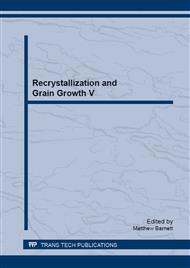p.201
p.207
p.213
p.217
p.221
p.225
p.231
p.235
p.239
Continuous and Discontinuous Recrystallization of 6013 Aluminum Alloy
Abstract:
In situ orientation mapping using TEM and calorimetric measurements were carried out to investigate the annealing behavior of cold-rolled 6013 aluminum alloy. The recrystallization of the material can be considered to be a number of processes that correspond to two separate stored energy release peaks. In the temperature range of the peak 1, the deformation zones around the large second-phase particles acted as sites for particle-stimulated nucleation. In the matrix, at the same time, some elongation of grains occurred. The elongated matrix grains appeared because of the reduction of the dislocation density and the annihilation of some low-angle grain boundaries between chains of subgrains lying in layers parallel to the sheet plane. The matrix processes in this temperatures range can be considered forms of continuous recrystallization. The matrix high-angle grain boundaries started to migrate at the temperature range of the peak 2. They moved mostly in the direction normal to the sheet plane. Heating of the sample for an appropriate time at those temperatures resulted in the complete discontinuous recrystallization of the material. The recrystallized microstructure was dominated now by elongated grains, which were a few times thicker than those obtained by annealing at the temperatures of the peak 1.
Info:
Periodical:
Pages:
221-224
Citation:
Online since:
March 2013
Authors:
Price:
Сopyright:
© 2013 Trans Tech Publications Ltd. All Rights Reserved
Share:
Citation:


